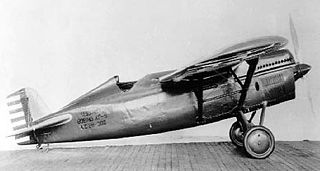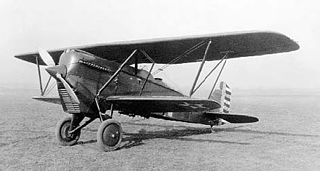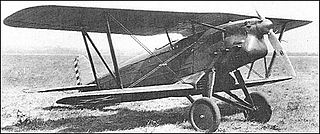
The McDonnell XF-88 Voodoo was a long-range, twin-engine jet fighter aircraft with swept wings designed for the United States Air Force. Although it never entered production, its design was adapted for the subsequent supersonic F-101 Voodoo.

The Curtiss-Wright XF-87 Blackhawk was a prototype American all-weather jet fighter interceptor and the company's last aircraft project. Designed as a replacement for the World War II–era propeller-driven P-61 Black Widow night/interceptor aircraft, the XF-87 lost in government procurement competition to the Northrop F-89 Scorpion. The loss of the contract was fatal to the company; the Curtiss-Wright Corporation closed down its aviation division, selling its assets to North American Aviation.

The North American YF-93 was an American fighter development of the F-86 Sabre that emerged as a radically different variant that received its own designation. Two were built and flown before the project was eventually canceled.

The Bell XFL Airabonita was an experimental carrier-based interceptor aircraft developed for the United States Navy by Bell Aircraft Corporation of Buffalo, New York. It was similar to and a parallel development of the U.S. Army Air Corps’ land-based P-39 Airacobra, differing mainly in the use of a tailwheel undercarriage in place of the P-39's tricycle gear. Only one prototype was built.

The Boeing XF8B was a single-engine aircraft developed by Boeing during World War II to provide the United States Navy with a long-range shipboard fighter aircraft. The XF8B was intended for operation against the Japanese home islands from aircraft carriers outside the range of Japanese land-based aircraft. Designed for various roles including interceptor, long-range escort fighter, dive-bomber, and torpedo bomber, the final design embodied a number of innovative features in order to accomplish the various roles. Despite its formidable capabilities, the XF8B-1 never entered series production.

The Vought XF3U was the prototype of a two-seat, all-metal biplane fighter, built by Vought Aircraft Company of Dallas, Texas for the United States Navy.

The Boeing XP-9 was the first monoplane fighter aircraft produced by the United States aircraft manufacturing company Boeing. It incorporated sophisticated structural refinements that were influential in later Boeing designs. The sole prototype exhibited unsatisfactory characteristics with its lack of pilot visibility directly leading to its cancellation.

The Boeing XF6B-1 / XBFB-1 was Boeing's last biplane design for the United States Navy. Only the one prototype, Model 236, was ever built; although first flying in early 1933, it rammed into a crash barrier in 1936 and the design was not pursued further.

The Vought XF2U was a prototype biplane fighter aircraft evaluated by the United States Navy at the end of the 1920s, but was already outclassed by competing designs and never put into production.

The Boeing XP-4 was a prototype United States biplane fighter of the 1920s that was grounded permanently after just 4.5 hours of flight testing.

The Boeing XP-7 was a prototype United States biplane fighter of the 1920s.

The Boeing XP-8 was a prototype American biplane fighter of the 1920s, notable for its unusual design incorporating the engine radiator into the lower wing.

The Boeing P-29 and XF7B-1 were an attempt to produce a more advanced version of the highly successful P-26. Although slight gains were made in performance, the U.S. Army Air Corps and U.S. Navy did not order the aircraft.

The Eberhart XFG was an American single-seat experimental ship-borne biplane fighter aircraft developed for the United States Navy in 1927 by the Eberhart Aeroplane and Motor Company. The sole prototype was rebuilt into the XF2G with the addition of a single float and a different engine, but the aircraft was destroyed in a crash in 1928, and the type did not enter production.

The Berliner-Joyce XF3J was an American biplane fighter, built by Berliner-Joyce Aircraft. It was submitted to the United States Navy for their request for a single-seat carrier-based fighter powered by a 625 hp (466 kW) Wright R-1510-26 engine.

The Curtis XF13C was a carrier-based fighter aircraft built by Curtiss Aeroplane and Motor Company.

The Douglas XFD was a carrier-based biplane fighter aircraft designed for the United States Navy, and the first fighter to be built by the Douglas Aircraft Company. A victim of changing requirements, no production was undertaken.

The Northrop XFT was an American prototype fighter aircraft of the 1930s. A single engined low-winged monoplane, it was designed and built to meet a United States Navy order for an advanced carrier based fighter. It exhibited poor handling, and was rejected by the Navy, the single prototype being lost in a crash. A variant, the Northrop 3A, also was unsuccessful.

The Vought V-141 was a prototype American single-seat fighter aircraft of the 1930s. It was a development of the unsuccessful Northrop 3-A design, but was itself a failure, being rejected by the United States Army Air Corps. The sole prototype was sold to the Japanese Army in 1937, but no production followed, with the type proving to be inferior to existing Japanese fighters.

The Thomas-Morse TM-24 was a prototype American two-seat observation aircraft of the 1920s. A single example was built in 1925, but no production followed.





















